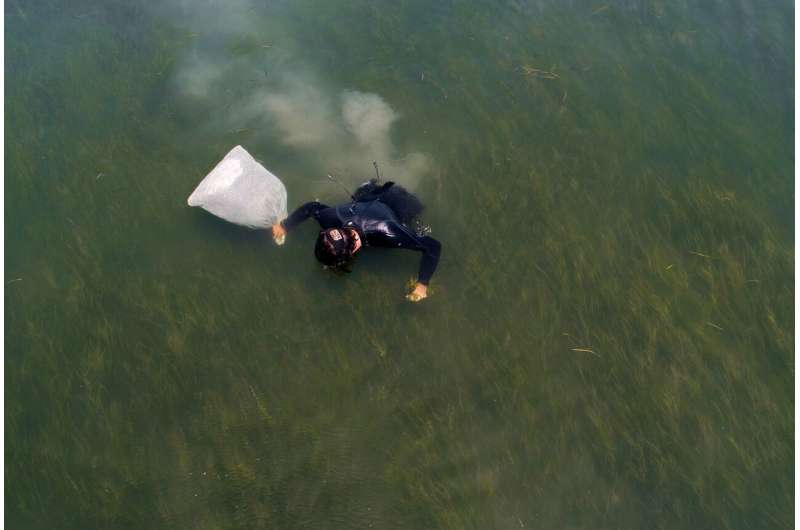Boosting Scotland's Coastline: Seagrass Planting And Ecosystem Recovery

Table of Contents
Scotland's stunning coastline, a breathtaking tapestry of rugged cliffs, sandy beaches, and vibrant marine life, is under increasing pressure. From pollution to habitat loss, our coastal ecosystems face significant challenges. This article explores the crucial role of seagrass planting in Scotland in restoring the health of our marine environment and the wider ecosystem. We'll delve into the remarkable benefits of seagrass restoration, the challenges involved, and how you can contribute to this vital conservation effort.
The Ecological Importance of Seagrass in Scotland
Seagrass meadows are often referred to as the "lungs of the sea," and for good reason. Their ecological importance to Scotland's coastline is undeniable.
Carbon Sequestration and Climate Change Mitigation
Seagrass meadows are incredibly effective carbon sinks, absorbing atmospheric CO2 at a rate significantly faster than terrestrial forests. This "blue carbon" sequestration is vital in mitigating climate change, making seagrass restoration a powerful tool in our fight against global warming. Scotland's seagrass species, including Zostera marina (common eelgrass) and Zostera noltii (dwarf eelgrass), play a crucial role in this process, locking away carbon in their sediments for centuries.
- Blue carbon: The term used to describe carbon captured by ocean and coastal ecosystems, including seagrass.
- Carbon sequestration rates: Research indicates significantly higher carbon capture rates in seagrass compared to land-based forests.
- Scottish species contribution: Specific studies on Scottish seagrass species and their carbon sequestration potential are increasingly important for informing restoration efforts.
Biodiversity and Habitat Provision
Seagrass beds provide critical nursery habitats for a vast array of commercially and ecologically important species. From juvenile fish like cod and plaice to shellfish like scallops and mussels, these underwater meadows teem with life. They also support a diverse range of invertebrates, providing a crucial link in the food web, benefiting the entire ecosystem.
- Nursery habitats: Seagrass provides shelter and food for young fish and shellfish, boosting population numbers.
- Biodiversity hotspots: Seagrass ecosystems support a high diversity of species, contributing to the overall biodiversity of Scotland's marine environment.
- Food web support: The complex ecosystem supported by seagrass benefits a wide range of marine life, strengthening the resilience of the entire coastal system.
Coastal Protection and Erosion Control
Seagrass meadows act as natural buffers, absorbing wave energy and reducing coastal erosion. Their dense root systems stabilize sediments, protecting coastlines and the valuable infrastructure they support. This natural protection offers significant economic benefits by reducing the need for expensive artificial coastal defenses.
- Wave attenuation: Seagrass reduces wave impact, minimizing erosion and protecting shorelines.
- Sediment stabilization: The root systems of seagrass bind sediments, preventing erosion and improving water clarity.
- Economic benefits: Reduced coastal erosion translates into lower costs associated with infrastructure maintenance and repair. Examples in Scotland include areas like the Solway Firth, where seagrass plays a key role in coastal stability.
Challenges and Opportunities in Seagrass Planting in Scotland
While the benefits of seagrass restoration are clear, challenges remain in implementing successful planting projects in Scotland.
Identifying Suitable Planting Sites
Careful site selection is crucial for successful seagrass planting. Factors such as water quality, depth, substrate type, light availability, and prevailing currents all influence the survival and growth of seagrass. Organizations like the Marine Scotland Science are actively involved in mapping suitable seagrass habitats and assessing their condition.
- Water quality: Pollution can severely impact seagrass health; clean, nutrient-poor waters are essential.
- Substrate type: Seagrass needs a suitable substrate to establish its roots, typically sandy or muddy sediments.
- Scientific assessment: Thorough surveys and assessments are vital before any planting commences to ensure the best chances of success.
Seagrass Planting Techniques and Success Rates
Several techniques exist for seagrass planting, including seed dispersal and the transplanting of seedlings. Each has its own advantages and challenges. Factors such as herbivory (grazing by animals), disease outbreaks, and environmental stressors can affect success rates. Ongoing research aims to improve techniques and increase survival rates.
- Seed dispersal: Scattering seagrass seeds directly into the seabed.
- Seedling transplantation: Transplanting small seagrass plants from established beds to new areas.
- Challenges: Herbivory, disease, and changes in environmental conditions can hinder seagrass growth and survival.
Community Engagement and Volunteer Involvement
Citizen science and community participation are crucial for the success and sustainability of seagrass planting projects. Many volunteer-led initiatives across Scotland actively engage local communities in monitoring, planting, and protecting seagrass meadows.
- Citizen science: Volunteers can assist with monitoring seagrass health and contributing valuable data.
- Volunteer planting: Community involvement in the physical act of planting seagrass significantly increases project success.
- Long-term sustainability: Community engagement ensures the long-term success of seagrass restoration projects.
Funding and Policy Supporting Seagrass Restoration in Scotland
Successful seagrass restoration requires adequate funding and supportive policies.
Government Initiatives and Funding Opportunities
The Scottish Government has shown increasing commitment to marine conservation, including funding for seagrass restoration projects. Various grants and programs support research, monitoring, and restoration efforts. Relevant environmental policies and legislation are vital frameworks for these initiatives.
- Government funding: Grants and funding opportunities are available to support seagrass restoration projects in Scotland.
- Environmental policies: Legislation and policies create the necessary regulatory framework for seagrass conservation.
- Scottish Environmental Protection Agency (SEPA): SEPA plays a crucial role in regulating and monitoring coastal environments.
Private Sector and Corporate Social Responsibility
The involvement of the private sector is increasingly important in funding and supporting seagrass restoration projects. Corporate social responsibility initiatives offer opportunities for businesses to invest in marine conservation, enhancing their brand image and contributing to a sustainable future.
- Corporate partnerships: Businesses can sponsor seagrass restoration projects and provide funding.
- CSR initiatives: Companies can integrate seagrass conservation into their CSR strategies.
- Mutual benefits: Seagrass restoration projects offer businesses opportunities to demonstrate environmental stewardship and social responsibility.
Conclusion
Seagrass planting in Scotland is vital for boosting our coastline's health and restoring its vibrant marine ecosystems. By recognizing the immense ecological importance of seagrass, tackling the challenges of restoration, and leveraging funding and community support, we can significantly improve the health of our coastal waters. Get involved in seagrass planting projects in Scotland – together, we can make a difference and protect this precious resource. Learn more about Seagrass Planting Scotland initiatives and how you can contribute to this vital conservation work today.

Featured Posts
-
 La Rivalidad Ufc Contra Canelo En Mexico
May 04, 2025
La Rivalidad Ufc Contra Canelo En Mexico
May 04, 2025 -
 Ufc 314 Volkanovski Lopes Headliner And Full Fight Card Preview
May 04, 2025
Ufc 314 Volkanovski Lopes Headliner And Full Fight Card Preview
May 04, 2025 -
 Ajagbas World Championship Bid Confidence And Preparation
May 04, 2025
Ajagbas World Championship Bid Confidence And Preparation
May 04, 2025 -
 Ufc Fight Night Sandhagen Vs Figueiredo Full Results And Highlights From Espn 67
May 04, 2025
Ufc Fight Night Sandhagen Vs Figueiredo Full Results And Highlights From Espn 67
May 04, 2025 -
 Anna Kendrick Shades Blake Lively A Simple Favor Premiere Moment
May 04, 2025
Anna Kendrick Shades Blake Lively A Simple Favor Premiere Moment
May 04, 2025
